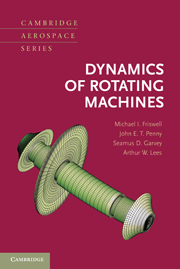Book contents
- Frontmatter
- Contents
- Preface
- Acronyms
- 1 Introduction
- 2 Introduction to Vibration Analysis
- 3 Free Lateral Response of Simple Rotor Models
- 4 Finite Element Modeling
- 5 Free Lateral Response of Complex Systems
- 6 Forced Lateral Response and Critical Speeds
- 7 Asymmetric Rotors and Other Sources of Instability
- 8 Balancing
- 9 Axial and Torsional Vibration
- 10 More Complex Rotordynamic Models
- Solutions to Problems
- Appendix 1 Properties of Solids
- Appendix 2 Stiffness and Mass Coefficients for Certain Beam Systems
- Appendix 3 Torsional Constants for Shaft Sections
- Bibliography
- Index
2 - Introduction to Vibration Analysis
Published online by Cambridge University Press: 05 February 2015
- Frontmatter
- Contents
- Preface
- Acronyms
- 1 Introduction
- 2 Introduction to Vibration Analysis
- 3 Free Lateral Response of Simple Rotor Models
- 4 Finite Element Modeling
- 5 Free Lateral Response of Complex Systems
- 6 Forced Lateral Response and Critical Speeds
- 7 Asymmetric Rotors and Other Sources of Instability
- 8 Balancing
- 9 Axial and Torsional Vibration
- 10 More Complex Rotordynamic Models
- Solutions to Problems
- Appendix 1 Properties of Solids
- Appendix 2 Stiffness and Mass Coefficients for Certain Beam Systems
- Appendix 3 Torsional Constants for Shaft Sections
- Bibliography
- Index
Summary
Introduction
In this chapter, we briefly examine the dynamic characteristics and properties of elastic systems composed of discrete components. In subsequent chapters, we extend and apply these ideas to the more complex problems arising from the dynamic analysis of continuous components, rotors, stators, and rotor–bearing–stator systems. Readers introduced to this material for the first time may need to consult other textbooks that develop these ideas in more detail and at a more measured pace (e.g., Inman, 2008; Meirovitch, 1986; Newland, 1989; Rao, 1990; Thompson, 1993). Here, the basic theory is reviewed in a manner suitable for those who already have some familiarity with it. For such readers, this chapter provides both a revision and a concise summary.
The purpose of analyzing any elastic system or structure is to determine the static or dynamic displacements (or strains) and to find the internal forces (or stress) in the system or structure. To determine displacements, we require a frame of reference from which to measure them. Before we can begin the analysis, however, we must create a mathematical model of our system that may be very simple – perhaps devised intuitively – and easy to analyze but provides information of limited accuracy. Conversely, it may be a very complex model that requires significant computation but provides relatively accurate information.
- Type
- Chapter
- Information
- Dynamics of Rotating Machines , pp. 17 - 75Publisher: Cambridge University PressPrint publication year: 2010



